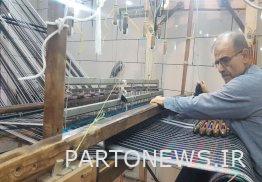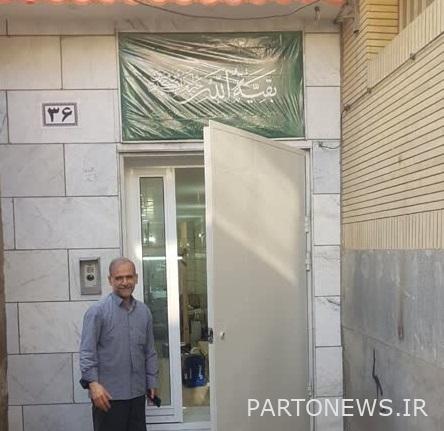Supplying raw materials is the most important problem of the art of poetry/art with more than a thousand years old

Seyyed Ali Manzavi Kashani said in an interview with Arya Heritage about the art of poetry weaving: This art has been produced and popular in most of the cities of Razavi Khorasan, including Mashhad, Sabzevar, and Torbat Heydarieh, and has been popular in the past, and arts such as bark weaving, furt weaving, and silk weaving We can also place in this category and sub-category wool weaving, most of its products are towels, chadorshab, baqcheh, etc.
This veteran master of shaarbafi added: Shaarafi is produced in two ways, simple and striped. Simple shaar is mostly woven in purple, crimson, black, yellow, eggplant, green and flower colors for women’s clothes, and bar shaar is woven in black and white with a width of 2 meters and a length of 1.5 meters for men’s clothes.
About the meaning of Shaerbafi, Manzavi said: Shaerbaf means Mutab or someone who weaves cloth from hair or silk. However, this word is used less now due to the fading of poetry.
He added: My father’s job was poetry weaving. I used to come to the poetry weaving workshop with my father when I was five years old, and at first I did small tasks such as bobbins and bobbins, due to the interest I got in this work after being in the workshop for a long time and working with I learned the machine from my father. Finally, one day I sat down behind the machine and started weaving, and gradually I gained full skill in weaving and I worked in my father’s workshop until I was 25 years old, until I went to Kashan.
The art of poetry is more than a thousand years old
The veteran master of hair weaving said about the age of this art: Some have mentioned that this hand-woven fabric is more than a thousand years old, the most beautiful hair weaving fabrics have been created throughout history by Yazdi, Isfahani and Kashani artists.
From migrating to Kashan to returning to Mashhad
The isolated master, who has a partial view of Kashan’s handwoven industry, further added: I migrated to Kashan in 1357 and worked in the Kashan velvet factory, but after working in this factory for a few months, I went to poetry weaving and started working in a poetry weaving workshop. Considering the fact that I had learned poetry weaving from my father, I did poetry weaving better than them.
He clarified: During the time I was in Kashan, I got to know the Shaerbafi market and even made a machine with taste and taste based on the needs of the market and returned to Mashhad. When I returned to Mashhad, I took Shaerbafi products from Mashhad to Kashan for sale.
Innovation in handwoven poetry
Stating that after I found the market for the sale of products in Kashan, this veteran weaver went on to innovate and continued: In the old looms, the threads were thin and would tear, that’s why it needed a lot of precision, that’s why some changes were made. I created in the yarn used.
He shows the handkerchief that is woven with poetry weaving and said about its production: I used to produce this handkerchief as before, but it took a lot of time to produce it and it was not economical, so I created the first innovation in this work and yarn and weaving. I changed it in such a way that not only did I spend less time to produce it, but the new napkins would also be more durable and strong.
His handkerchiefs are not only sold in the markets of Mashhad, but also in the markets of other cities in Iran. Of course, women still use this handkerchief as a headscarf in the cities of North Khorasan.
Ustad Manzavi said about his products: I produce 10 to 12 handkerchiefs daily and each handkerchief is sold for around 100 thousand Tomans.
The concern of providing raw materials
One of his challenges and concerns to continue working in this traditional art is to provide raw materials.
According to him, there is a shortage of yarns that are uniformly dyed and of good quality in the market, and this is one of the most important problems of poetry weaving.
About the problems of marketing and sales of this art, this veteran poet said: I have almost no marketing for the products produced by the poet workshop, and all customers are traditionally buyers of products from the past.
Request to install a sign for the poetry weaving workshop
Referring to the presence of millions of pilgrims and travelers in Mashhad, he stated: This workshop has been active in the same place for more than 70 years and is the only poetry weaving workshop in Mashhad that has remained from the past. If the municipality installs a sign at the beginning of the street that this There is a poetry weaving workshop alley, pilgrims and tourists will visit the workshop of this old art of Mashhad and buy the products of the workshop.
The municipality should not charge fees for the prosperity of poetry weaving
The isolated master, who is considered one of the honors of Mashhad city, does not need financial assistance from any institution or organization, but what can give him hope is more attention, so that he does not have to cover the workshop sign to avoid paying municipal fees.
Poetry Museum
You can see works and objects from the history and past of Mashhad’s poetry weaving workshop in the corners of Master Manzovi’s poetry workshop. Some of the items in Master Manzovi’s poetry workshop are definitely museum objects that should be kept in the museum if there is a museum of poetry weaving. He shows us an old masoorah, which he says is more than 100 years old. These threads have been kept by him for more than ten years and are a memory of Shaerbafi’s childhood.
 Selected craftsman of 1368
Selected craftsman of 1368
This pioneer of poetry weaving, as he weaves poetry, stops working from time to time and turns the pages of his diary, from the days when he used to weave poetry with enthusiasm and this made his original art to be seen, he died in 1368 Dastbafi was chosen as the chosen craftsman of the year and was honored by the Organization of Cultural Heritage, Tourism and Handicrafts.
Recipient of the UNESCO Award
In 2018, Ustad Manzavi received the National Award of Excellence for the work of Jajim Karak in 2018 with the coordination and follow-up of the Deputy of Handicrafts of the province, and received the UNESCO Award for the same work from the United Nations World Scientific and Cultural Organization (UNESCO) in 2018.
The case of the honors of Master Manzavi is still being completed, according to Reza Ebrahimnia, head of handicrafts department of the General Department of Cultural Heritage, Tourism and Handicrafts of Khorasan Razavi, the file for receiving the first degree artistic badge of Master Seyed Ali Manzavi has been prepared and sent to Tehran.


